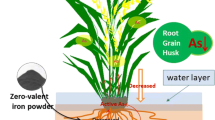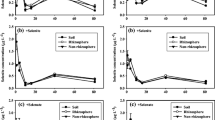Abstract
Background and aims
Iron plaque on roots has been hypothesized to be an effective restraint on the uptake of arsenic (As) by rice plants. Evaluating the formation of iron plaque and its effect on As uptake by various rice cultivars is valuable because selecting low As uptake rice cultivars results in reduced risks associated with rice consumption. This study examines iron plaque formation and its effect on As uptake by different genotypes of rice cultivars.
Methods
Hydroponic cultures were conducted in phytotron at day 25/night 20°C and the rice seedlings in fifth-leaf age were treated with Fe (II) at the levels of 0 and 100 mg L−1 in the Kimura B nutrient solutions for 14 days. The amount of iron plaque formation of 28 rice cultivars was determined by using the DCB extractable Fe of roots. Four cultivars representing high and low iron plaque formation capability, from indica and japonica respectively, were selected out of the 28 cultivars and processed for Fe and As treatments. After Fe treatments for 4 days, the seedlings were fed with As (III) at levels of 0, 0.5, and 1 mg L−1 for another 10 days. We were thus able to determine the amounts of iron plaque formation and the As content in iron plaque, roots, and shoots of the four tested cultivars.
Results
Iron plaque formation capability differed among tested twenty-eight rice cultivars. Feeding As to four tested cultivars enhanced iron plaque formation on roots; the As uptake by roots and shoots was decreased by the addition of Fe. Both the retention of As on iron plaque and the decrease of As uptake by the addition of Fe varied among tested cultivars and were not correlated with the iron plaque formation capability.
Conclusions
Iron plaque can sequestrate As on the roots and reduce rice’s As uptake. However, other factors also influence the As uptake, namely the differences in binding affinity of iron plaque to As, the existent As species in the rhizosphere, and the uptake capability of various As species by rice plants. These factors should also be considered when selecting low As uptake rice cultivars.






Similar content being viewed by others
References
Abedin MJ, Feldmann J, Meharg AA (2002) Uptake kinetics of arsenic species in rice plants. Plant Physiol 128:1120–1128
Ahmed ZU, Panaullah GM, Gauch H, McCouch SR, Tyagi W, Kabir MS, Duxbury JM (2011) Genotype and environment effects on rice (Oryza sativa L.) grain arsenic concentration in Bangladesh. Plant Soil 338:367–382
Arao T, Kawasaki A, Baba K, Matsumoto S (2011) Effects of arsenic compound amendment on arsenic speciation in rice grain. Environ Sci Technol 45:1291–1297
Bacha RE, Hossner LR (1977) Characteristics of coatings formed on rice roots as affected by iron and manganese additions. Soil Sci Soc Am J 41:931–935
Chen CC, Dixon JB, Turner FT (1980) Iron coating on rice roots: Morphology and models of development. Soil Sci Soc Am J 44:1113–1119
Chen Z, Zhu YG, Liu WJ, Meharg AA (2005) Direct evidence showing the effect of root surface iron plaque on arsenite and arsenate uptake into rice (Oryza sativa) roots. New Phytol 165:91–97
Cornell RM, Schwertmann U (2003) The iron oxides- structure, properties, reactions occurrences and uses. Wiley-VCH, Weinheim
Crowder AA, Coltman DW (1993) Formation of manganese oxide plaque on rice roots in solution culture under varying pH and manganese (Mn2+) concentration conditions. J Plant Nutr 16:589–559
Deng D, Wu SC, Wu FY, Deng H, Wong MH (2010) Effects of root anatomy and Fe plaque on arsenic uptake by rice seedlings grown in solution culture. Environ Pollut 158:2589–2595
Dixit S, Hering J (2006) Sorption of Fe(II) and As(III) on goethite in single- and dual-sorbate systems. Chem Geol 228:6–15
Dwivedi S, Tripathi RD, Srivastava S, Singh R, Kumar A, Tripathi P, Dave R, Rai UN, Chakrabarty D, Trivedi PK, Tuli R, Adhikari B, Bag MK (2010) Arsenic affects mineral nutrients in grains of various Indian rice (Oryza sativa L.) genotypes grown on arsenic-contaminated soils of West Bengal. Protoplasma 245:113–124
Geng CN, Zhu YG, Liu WJ, Smith SE (2005) Arsenate uptake and translocation in seedlings of two genotypes of rice is affected by external phosphate concentrations. Aquat Bot 83:321–331
Green MS, Etherington JR (1977) Oxidation of ferrous iron by rice (Oryza-sativa-L.) roots: Mechanism for waterlogging tolerance. J Exp Bot 28:678–690
Hu Y, Li JH, Zhu YG, Huang YZ, Hu HQ, Christie P (2005) Sequestration of As by iron plaque on the roots of three rice (Oryza sativa L.) cultivars in a low-P soil with or without P fertilizer. Environ Geochem Health 27:169–176
Jien SH, Hseu ZY, Chen ZS (2010) Hydropedological implications of ferromanganiferous nodules in rice-growing plinthitic Ultisols under different moisture regimes. Soil Sci Soc Am J 74:880–891
Li H, Ye ZH, Wei ZJ, Wong MH (2011) Root porosity and radial oxygen loss related to arsenic tolerance and uptake in wetland plants. Environ Pollut 159:30–37
Liu JG, Leng XM, Wang MX, Zhu ZQ, Dai QH (2011) Iron plaque formation on roots of different rice cultivars and the relation with lead uptake. Ecotox Environ Safe 74:1304–1309
Liu WJ, Zhu YG, Smith FA, Smith SE (2004) Do iron plaque and genotypes affect arsenate uptake and translocation by rice seedlings (Oryza sativa L.) grown in solution culture? J Exp Bot 55:1707–1713
Ma JF, Yamaji N, Mitani N, Xu XY, Su YH, McGrath SP, Zhao FJ (2008) Transporters of arsenite in rice and their role in arsenic accumulation in rice grain. Proc Natl Acad Sci USA 105:9931–9935
Meharg AA, Williams PN, Adomako E, Lawgali YY, Deacon C, Villada A, Cambell RCJ, Sun G, Zhu YG, Feldmann J, Raab A, Zhao FJ, Islam R, Hossain S, Yanai J (2009) Geographical variation in total and inorganic arsenic content of polished (wite) rice. Environ Sci Technol 43:1612–1617
Mei XQ, Ye ZH, Wong MH (2009) The relationship of root porosity and radial oxygen loss on arsenic tolerance and uptake in rice grains and straw. Environ Pollut 157:2550–2557
Mishra S, Jha AB, Dubey RS (2011) Arsenite treatment induces oxidative stress, upregulates antioxidant system, and causes phytochelatin synthesis in rice seedlings. Protoplasma 248:565–577
Norton GJ, Duan GL, Dasgupta T, Islam MR, Lei M, Zhu YG, Deacon CM, Moran AC, Islam S, Zhao FJ, Stroud JL, McGrath SP, Feldmann J, Price AH, Meharg AA (2009) Environmental and genetic control of arsenic accumulation and speciation in rice grain: Comparing a range of common cultivars grown in contaminated sites across Bangladesh, China, and India. Environ Sci Technol 43:8381–8386
Otte ML, Rozema J, Koster L, Haarsma MS, Broekman RA (1989) Iron plaque on roots of Aster tripolium L.: interaction with zinc uptake. New Phytol 111:309–317
Panaullah GM, Alam T, Hossain MB, Loeppert RH, Lauren JG, Meisner CA, Ahmed ZU, Duxbury JM (2009) Arsenic toxicity to rice (Oryza sativa L.) in Bangladesh. Plant Soil 317:31–39
Raven KP, Jain A, Loeppert RH (1998) Arsenite and arsenate adsorption on ferrihydrite: Kinetics, equilibrium, and adsorption envelopes. Environ Sci Technol 32:344–349
Seyfferth AL, Webb SM, Andrews JC, Fendorf S (2010) Arsenic localization, speciation, and co-occurrence with iron on rice (Oryza sativa L.) roots having variable Fe coatings. Environ Sci Technol 44:8108–8113
Seyfferth AL, Webb SM, Andrews JC, Fendorf S (2011) Defining the distribution of arsenic species and plant nutrients in rice (Oryza sativa L.) from the root to the grain. Geochim Cosmochim Acta 75:6655–6671
Su YH, McGrath SP, Zhao FJ (2010) Rice is more efficient in arsenite uptake and translocation than wheat and barley. Plant Soil 328:27–34
Sun G, Williams PN, Zhu Y, Deacon C, Carey A, Raab A, Feldmann J, Meharg AA (2009) Survey of arsenic and its speciation in rice products such as breakfast cereals, rice crackers and Japanese rice condiments. Environ Int 35:473–475
Ultra VU, Nakayama A, Tanaka S, Kang YM, Sakurai K, Iwasaki K (2009) Potential for the alleviation of arsenic toxicity in paddy rice using amorphous iron-(hydr)oxide amendments. Soil Sci Plant Nutri 55:160–169
Waychunas GA, Rea BA, Fuller CC, Davis JA (1993) Surface chemistry of ferrihydrite: Part 1. EXAFS studies of the geometry of coprecipitated and adsorbed arsenate. Geochim Cosmochim Acta 57:2251–2269
Wu C, Ye ZH, Shu WS, Zhu YG, Wong MH (2011a) Arsenic accumulation and speciation in rice are affected by root aeration and variation of genotypes. J Exp Bot 62:2889–2898
Wu C, Ye ZH, Li H, Wu SC, Deng D, Zhu YG, Wong MH (2012) Do radial oxygen loss and external aeration affect iron plaque formation and arsenic accumulation and speciation in rice? J Exp Bot. doi:10.1093/jxb/ers017
Wu ZC, Ren HY, McGrath SP, Wu P, Zhao FJ (2011b) Investigating the contribution of the phosphate transport pathway to arsenic accumulation in rice. Plant Physiol 157:498–508
Acknowledgments
The financial support from the National Science Council, Executive Yuan, Taiwan (grant no. NSC-98-2313-B-002-028-MY3) is sincerely appreciated.
Author information
Authors and Affiliations
Corresponding author
Additional information
Responsible Editor: Henk Schat.
Dr. Chia-Hsing Lee and Mr. Yi-Cheng Hsieh are equal contributors to this paper.
Rights and permissions
About this article
Cite this article
Lee, CH., Hsieh, YC., Lin, TH. et al. Iron plaque formation and its effect on arsenic uptake by different genotypes of paddy rice. Plant Soil 363, 231–241 (2013). https://doi.org/10.1007/s11104-012-1308-2
Received:
Accepted:
Published:
Issue Date:
DOI: https://doi.org/10.1007/s11104-012-1308-2




